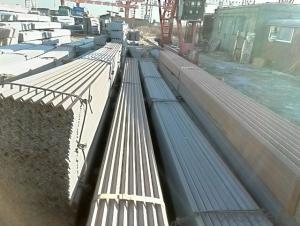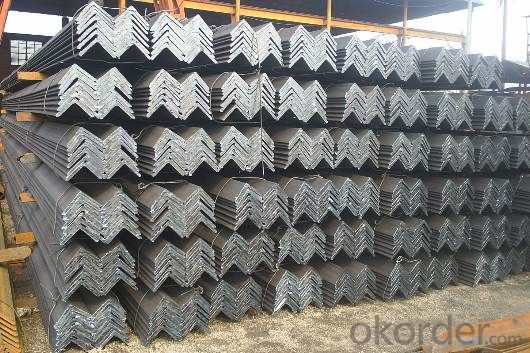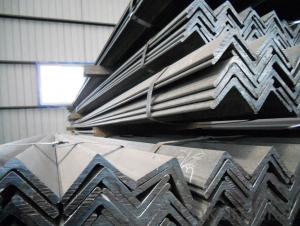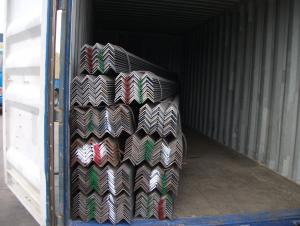Hot Rolled Equal Angle Steel with Best Price
- Loading Port:
- Tianjin
- Payment Terms:
- TT OR LC
- Min Order Qty:
- 25 m.t.
- Supply Capability:
- 20000 m.t./month
OKorder Service Pledge
OKorder Financial Service
You Might Also Like
Product Description:
OKorder is offering high quality Hot Rolled Equal Angle Steel at great prices with worldwide shipping. Our supplier is a world-class manufacturer of steel, with our products utilized the world over. OKorder annually supplies products to European, North American and Asian markets. We provide quotations within 24 hours of receiving an inquiry and guarantee competitive prices.
Product Applications:
Hot Rolled Equal Angle Steels are ideal for structural applications and are widely used in the construction of buildings and bridges, and the manufacturing, petrochemical, and transportation industries.
Product Advantages:
OKorder's Hot Rolled Equal Angle Steels are durable, strong, and resist corrosion.
Main Product Features:
· Premium quality
· Prompt delivery & seaworthy packing (30 days after receiving deposit)
· Corrosion resistance
· Can be recycled and reused
· Mill test certification
· Professional Service
· Competitive pricing
Product Specifications:
Manufacture: Hot rolled
Grade: Q195 – 235
Certificates: ISO, SGS, BV, CIQ
Length: 6m – 12m, as per customer request
Packaging: Export packing, nude packing, bundled
Sizes: 25mm-250mm | ||
a*t | ||
25*2.5-4.0 | 70*6.0-9.0 | 130*9.0-15 |
30*2.5-6.6 | 75*6.0-9.0 | 140*10-14 |
36*3.0-5.0 | 80*5.0-10 | 150*10-20 |
38*2.3-6.0 | 90*7.0-10 | 160*10-16 |
40*3.0-5.0 | 100*6.0-12 | 175*12-15 |
45*4.0-6.0 | 110*8.0-10 | 180*12-18 |
50*4.0-6.0 | 120*6.0-15 | 200*14-25 |
60*4.0-8.0 | 125*8.0-14 | 250*25 |
FAQ:
Q1: Why buy Materials & Equipment from OKorder.com?
A1: All products offered byOKorder.com are carefully selected from China's most reliable manufacturing enterprises. Through its ISO certifications, OKorder.com adheres to the highest standards and a commitment to supply chain safety and customer satisfaction.
Q2: What makes stainless steel stainless?
A2: Stainless steel must contain at least 10.5 % chromium. It is this element that reacts with the oxygen in the air to form a complex chrome-oxide surface layer that is invisible but strong enough to prevent further oxygen from "staining" (rusting) the surface. Higher levels of chromium and the addition of other alloying elements such as nickel and molybdenum enhance this surface layer and improve the corrosion resistance of the stainless material.
Q3: Can stainless steel rust?
A3: Stainless does not "rust" as you think of regular steel rusting with a red oxide on the surface that flakes off. If you see red rust it is probably due to some iron particles that have contaminated the surface of the stainless steel and it is these iron particles that are rusting. Look at the source of the rusting and see if you can remove it from the surface.
Images:



- Q: How do steel angles contribute to the overall stability of a truss system?
- Steel angles play a crucial role in enhancing the overall stability of a truss system. Truss systems are widely used in various structural applications, such as bridges and buildings, to provide support and distribute loads efficiently. The steel angles within a truss system contribute to its stability in several ways. Firstly, steel angles are commonly used as diagonal members within the truss system. These diagonal members help to resist both tensile and compressive forces that act on the structure. By strategically placing these steel angles, the truss system gains resistance against lateral loads, such as wind or seismic forces, which can cause the structure to sway or collapse. The diagonal angles effectively transfer these loads to the vertical and horizontal members of the truss, ensuring the stability of the entire system. Additionally, steel angles also provide stability by preventing the buckling or twisting of truss members. Buckling refers to the sudden failure of a structural member under compressive stress, while twisting refers to the rotational deformation of a member due to lateral forces. By incorporating steel angles as bracing elements, the truss system becomes more resistant to these types of deformations. The angles act as rigid supports, preventing the members from buckling or twisting, thus enhancing the overall stability of the truss system. Furthermore, steel angles help to increase the rigidity of the truss system. Rigidity refers to the stiffness and resistance to deformation of a structure. By connecting various truss members with steel angles, the overall rigidity of the truss system is improved. This increased rigidity enables the truss to bear heavier loads and provides overall stability and durability to the structure. In conclusion, steel angles are essential in contributing to the overall stability of a truss system. They provide resistance against lateral loads, prevent buckling and twisting of members, and increase the rigidity of the structure. By incorporating steel angles strategically within a truss system, engineers can ensure the stability and strength of the structure, making it capable of withstanding various external forces.
- Q: Can steel angles be used in architectural lighting installations?
- Indeed, architectural lighting installations can incorporate steel angles. Given their robustness, longevity, and adaptability, steel angles are frequently employed in construction ventures. Within the realm of architectural lighting, these steel angles serve as a foundation for illuminating apparatuses, as well as fixtures for wall or ceiling-mounted lights, or even as a framework for track lighting systems. Moreover, steel angles can be effortlessly tailored and fabricated to satisfy precise design specifications, thereby rendering them appropriate for a diverse range of architectural lighting applications.
- Q: Can steel angles be used in the construction of industrial chimneys?
- Yes, steel angles can be used in the construction of industrial chimneys. Steel angles are commonly used as structural components in various construction projects due to their strength, durability, and versatility. In the case of industrial chimneys, steel angles can be used to provide support and stability to the chimney structure. They can be incorporated into the design to reinforce the chimney's framework, particularly at the corners and joints where additional strength is required. Additionally, steel angles can also be used to create a base or foundation for the chimney, ensuring stability and preventing any potential structural issues. Overall, steel angles are a suitable choice for the construction of industrial chimneys due to their ability to withstand the high temperatures and harsh conditions associated with chimney operation.
- Q: Are steel angles subject to deformation?
- Yes, steel angles can be subject to deformation under certain conditions. The extent of deformation depends on various factors such as the load applied, the quality of the steel, and the design of the angle. However, steel angles are generally known for their strength and resistance to deformation compared to other materials.
- Q: Are steel angles resistant to chemical corrosion?
- Yes, steel angles are resistant to chemical corrosion to some extent. Steel is known for its strength and durability, but it can still corrode when exposed to certain chemicals and corrosive environments. However, steel angles are often coated or treated with protective materials such as galvanization, which significantly enhances their resistance to chemical corrosion. Galvanized steel angles have a layer of zinc applied to their surface, which acts as a barrier against corrosive substances. This coating helps to prevent the steel from coming into direct contact with chemicals, thus reducing the risk of corrosion. Nonetheless, it is important to note that the level of resistance may vary depending on the specific chemical and the duration and intensity of exposure. Regular maintenance and inspection are necessary to ensure the long-term corrosion resistance of steel angles.
- Q: Are steel angles resistant to UV radiation or fading?
- No, steel angles are not resistant to UV radiation or fading.
- Q: What are the different packaging options for steel angles?
- The different packaging options for steel angles typically include bundles, pallets, or crates. Bundles are commonly used for smaller quantities and are secured with steel straps. Pallets are used for larger quantities and provide ease of handling and transportation. Crates are used for heavy-duty and long-distance shipments, offering added protection and stability.
- Q: What are the different methods of surface preparation for painting steel angles?
- There are several methods of surface preparation for painting steel angles, each of which have their own benefits and considerations. 1. Manual cleaning: This method involves using hand tools such as wire brushes, sandpaper, or scrapers to remove loose rust, mill scale, and other contaminants. While it is a cost-effective option, it may not be suitable for large-scale projects or areas that are difficult to access. 2. Power tool cleaning: Power tools like grinders, sanders, or wire wheels can be used to mechanically remove rust, scale, and old paint from the surface of steel angles. This method is more efficient than manual cleaning and can be used in larger projects, but proper safety precautions and protective gear should be used. 3. Chemical cleaning: Chemical cleaning involves using solvents or acidic solutions to dissolve rust and remove contaminants from the steel surface. This method is effective for heavily corroded or hard-to-reach areas, but it requires careful handling and disposal of the chemicals. 4. Abrasive blasting: Abrasive blasting, also known as sandblasting, uses compressed air to propel abrasive materials such as sand, grit, or glass beads onto the surface of steel angles. This method is highly effective in removing all types of contaminants, providing a clean and rough surface for paint adhesion. However, it requires specialized equipment and should be conducted by trained professionals due to potential health hazards. Regardless of the method chosen, it is essential to ensure that the steel angles are thoroughly cleaned and free from contaminants before painting. This will help to achieve better paint adhesion, prolong the lifespan of the coating, and enhance the overall durability of the steel structure.
- Q: How do you clean and maintain steel angles?
- To clean and maintain steel angles, start by removing any surface dirt or debris using a soft cloth or brush. Then, prepare a mixture of mild soap and warm water and use it to wipe down the angles thoroughly. Rinse the angles with clean water and dry them completely to prevent rust formation. It's advisable to apply a light coat of oil or a rust inhibitor to protect the steel angles from corrosion. Regular inspections and prompt removal of any accumulated dirt or moisture will help maintain the steel angles' quality and prolong their lifespan.
- Q: What is the weight of a steel angle?
- The weight of a steel angle can vary depending on its dimensions and composition.
Send your message to us
Hot Rolled Equal Angle Steel with Best Price
- Loading Port:
- Tianjin
- Payment Terms:
- TT OR LC
- Min Order Qty:
- 25 m.t.
- Supply Capability:
- 20000 m.t./month
OKorder Service Pledge
OKorder Financial Service
Similar products
Hot products
Hot Searches
Related keywords




























